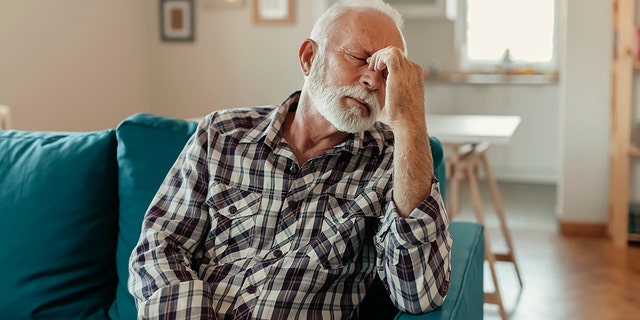Migraine sufferers are no strangers to major headaches.
The onset of a migraine can be painful, disorienting and sometimes even debilitating.
During National Migraine and Headache Awareness Month, Fox News Digital spoke to neurologist and headache specialist Lauren R. Natbony, M.D., to break down a few common myths and misconceptions about the condition.
MIGRAINE NASAL SPRAY FROM PFIZER SNAGS FDA APPROVAL FOR EXPECTED SUMMER LAUNCH
Natbony, founder and medical director of Integrative Headache Medicine of New York, described how migraines differ from headaches, as they are a “debilitating neurological disease characterized by recurrent episodes of severe head pain.”
Migraines are also associated with sensitivity to light and sound — and can cause nausea and vomiting, according to Mayo Clinic.
Some 31 million adults in the U.S. suffer from migraines, according to 2020 Census data.
More than 90% of people who live with migraines are unable to work or function normally during attacks, the Migraine Research Foundation reported.
Migraine pain affects more than 37 million people in the U.S.
College student and migraine sufferer Paige Daufenbach shared with Fox News Digital that a “bad” migraine attack gives her nausea, “drilling” head pain, auras and sensitivity to light and sound.
MIGRAINE VS. HEADACHE: HOW TO TELL THE DIFFERENCE AND WHEN TO SEEK HELP
“In the worst cases, I can’t even get out of bed and need to lie down with no lights on,” she said.
But not all migraine attacks are the same, Natbony explained.

“Each of my patients with migraine is unique and each requires a unique management plan,” she said.
“Migraine treatment isn’t one-size-fits-all.”
Treating migraines
A “comprehensive treatment strategy” is “vital” to migraine prevention, Natbony suggested. This might include lifestyle modifications, preventative treatment and rescue steps.
“It may take time to find the most effective combination of therapies,” she said. “I tell my patients that we need to keep exploring different strategies, such as medication, lifestyle changes and alternative therapies, until we find what works best.”
“In the worst cases, I can’t even get out of bed and need to lie down with no lights on.”
Lifestyle modifications can include getting regular sleep, hydrating with at least 64 ounces of water per day, eating a protein-rich meal or snack every three to four hours, and getting 30-45 minutes of cardiovascular exercise at least four times a week, she said.
REM SLEEP LOWER IN MIGRAINE SUFFERERS: STUDY
Preventative treatment is a must when headaches occur six or more days per month or are “debilitating,” the neurologist said.
“Preventative treatment aims to reduce the frequency and severity of migraine attacks,” she explained.

“Preventative therapies include vitamin supplements, prescription medications, medical devices and complementary treatments, such as acupuncture and biofeedback,” Natbony added.
Meanwhile, acute “rescue” treatments aim to relieve pain and associated symptoms when attacks occur.
Most of these acute medications are most effective when taken early in an attack, Natbony shared, due to central sensitization — a process that causes the nervous system to become hypersensitive to pain.
FIRST MIGRAINE DRUG TO BOTH BLOCK, TACKLE HEADACHES ‘SHIFTS PARADIGM’ OF TREATMENT
“When taken early, triptans, gepants and over-the-counter pain relievers have a better chance of halting the migraine process before central sensitization becomes fully established,” she explained.
Natbony recommends alternative remedies such as nasal sprays to relieve migraine symptoms. These deliver the medication directly to the upper nasal space, avoiding the GI tract — a route that is ideal for central nervous system drugs, according to a 2020 U.S. Neurology review.

“This also allows for fast-acting pain relief no matter when the spray is used during a migraine,” she said.
“It is effective at the onset and after central sensitization has set in,” she added.
So, “with this medication, patients don’t need to worry about missing their treatment window.”
FOODS THAT CAUSE HEADACHES: CHOOSE YOUR CHEESE, WINE, COFFEE AND CHOCOLATE CAREFULLY
A 2017 survey from The Journal of Head and Face Pain revealed that out of nearly 4,000 respondents who used oral acute prescription medication for migraines, 96% said they were dissatisfied with at least one aspect of their treatment.
“Due to gastric breakdown and absorption in the intestines, oral medications generally take longer to reach therapeutic levels in the bloodstream,” Natbony explained.

“Nasal sprays can also be useful for individuals who experience nausea or vomiting during migraine attacks, as they bypass the gastrointestinal system,” she said.
It’s important for patients to consult with their doctors to discuss possible side effects before trying nasal treatments, Natbony added.
Prepping your ‘migraine toolbox’
Migraine sufferers might want to consider setting up a “migraine toolbox” made up of multiple tools and techniques to tackle a migraine at its start.
An ideal toolbox, according to Natbony, should include abortive and rescue medications to stop migraines, preventative treatments, non-invasive medical devices and non-pharmaceutical treatments, such as supplements, acupuncture and biotherapies.
CLICK HERE TO SIGN UP FOR OUR HEALTH NEWSLETTER
It may also include over-the-counter tools like ice and heat packs and essential oils.
“A migraine toolbox has everything a patient may need, readily available in case an attack occurs,” Natbony said.

“It is important to be prepared with treatment options that work because a migraine can affect your day in a second,” she added.
Migraine sufferer Daufenbach revealed that she has multiple oral medications in her migraine toolbox, but she resorts to her “rescue” nasal spray treatment in severe cases.
“My neurologist recommended I try the nasal spray Trudhesa because of its flexibility and ability to give me fast pain relief in as few as 15 minutes,” she said.
“When I sense a bad migraine coming on, I get auras and my left arm goes numb,” she described. “That’s my cue that my pills aren’t going to give me the relief I need, and I know I can count on [the spray] when I have an important test or plans that I cannot miss.”
Migraine pain affects more than 37 million people in the U.S., according to the American Migraine Foundation.
Read the full article here